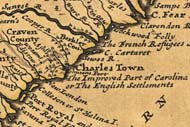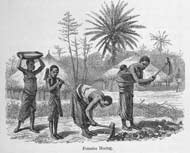Seeds of Wealth
The English established their first permanent settlement in Carolina in 1670. By 1680, settlers began to acquire land along Goose Creek and the Ashley River since both rivers offered direct access to Charleston via the Cooper River. These early planters, with the knowledge and labor of enslaved Africans, would make vast fortunes by growing rice in inland swamps. Indeed, the story of rice in Carolina dates from the earliest period of the colony when the Proprietors listed it as an experimental crop. By 1694, the crop was so well that the Proprietors accepted it as a means of paying land taxes.
Rice became a get rich quick crop just as sugar had in the West Indies. Rice planting families such as the Izards, Barkers, Middletons, Coachmans, Wrights, Warings, Parkers, and Childs all owned large estates; many built brick homes along the rivers to display their new wealth. In the middle of the 1700s, they added indigo as a cash crop. The planters reaped large profits from indigo due to a British bounty on the dye. All of the former plantations through which Palmetto Commerce Parkway passes grew inland rice throughout the 18th century. Remnants of some of the earliest rice fields constructed in Carolina are still present along the parkway.
It is no coincidence that as rice production took hold in the new colony, the number of African captives imported into Carolina also increased dramatically. By the early 18th century thousands of enslaved people were taken from Africa to supply the ever increasing demand for slave labor. Planters preferred people from Africa’s rice growing regions. They brought not only their labor but their knowledge of growing rice and many other skills. Slaves were brick masons, black smiths, seamstresses, cooks, basket makers, potters, boat builders, and farmers.
Further Exploration
Transatlantic Slave Trade Database
www.slavevoyages.org
Carolina Lowcountry and the Atlantic World
www.cofc.edu/atlanticworld/
South Carolina Historical Society
www.southcarolinahistoricalsociety.org
The After Slavery Project
www.afterslavery.com
Avery Research Center for African American History and Culture
www.avery.cofc.edu
Penn Center
www.penncenter.com
Many Thousands Gone, the First Two Centuries of Slavery in North America
by Ira Berlin, Harvard University Press, Cambridge, Massachusetts, 1998.
South Carolina, A History
by Walter Edgar, University of Press, Columbia, 1998.
Rice and Slaves, Ethnicity and the Slave Trade in Colonial South Carolina
by Daniel Littlefield, University of Illinois Press, Urbana.
The Economy of British America 1607-1789
by John McCusker and Russell Menard, University of North Carolina Press, Chapel Hill, 1985.
Rivers and Regions of Early South Carolina, Articles from the South Carolina Historical and Genealogical Magazine
by Henry A. M. Smith, The Reprint Publishers, Spartanburg, 1988.
Black Majority, Negroes in Colonial South Carolina from 1670 through the Stono Rebellion
by Peter Wood, W.W. Norton and Company, New York, 1974.
The Atlantic Slave Trade
by Johannes Postma, University of Florida Press, Gainesville, 2003.



